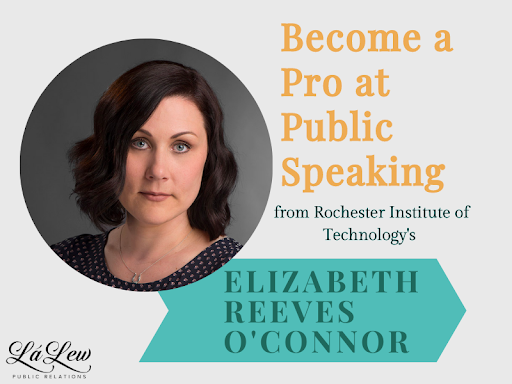More than just words: Elizabeth Reeves O’Connor’s Public Speaking Practices
Say it louder for those in the back! Cut out the filler words! Make good eye contact! When it comes to public speaking, it is much easier said than done. As communications professionals, the ability to express ideas and bring visions to life is our sweet spot. But, there is always more to learn!
At LáLew, we provide professional development opportunities for our team so that they can continue to grow and expand their skills, interests and practices. This week, we heard from public speaking expert, Elizabeth Reeves O’Connor. In addition to teaching multiple courses in communication at Rochester Institute of Technology (RIT), O’Connor is a director at RIT’s Expressive Communication Center.
In just 20 minutes (exactly!), O’Connor shared her public speaking journey and gave us some tips to captivate the room – or Zoom room.
“Give yourself the gift of preparation”
Thinking on your feet comes with time. For those just starting their careers, a distraction or unexpected interruption may be enough to derail an unprepared speaker. However, if you prepare and practice, starting with a detailed outline then simplifying to talking points, you will be able to easily recover from and overcome day-of obstacles.
“If you’re not using an outline, start using one”
O’Connor treats speaking like a process, using Cicero’s canons of rhetoric to hone in on her purpose, audience and goal while also keeping time in mind. The audience should be presented a road map, with a clear beginning, middle and end. This way, when attention spans are tested, your key takeaway won’t be lost.
“Virtual presentations … it’s a whole new animal”
Many teams (including ours) are using video conferencing for meetings and presentations. With this new space comes a whole new set of opportunities and challenges. O’Connor recommends users prioritize natural light, keep their eyes on the camera to simulate eye contact and maintain good posture with their feet firmly planted. As audiences will have an up-close view of your visual aids, make sure every slide or image is well executed.
What can you do?
Think back to the last speech you gave. What did you like? What could have gone a bit better? As O’Connor shared, being a better public speaker comes with time, practice, and preparation. Try out these tips and see how you grow!

